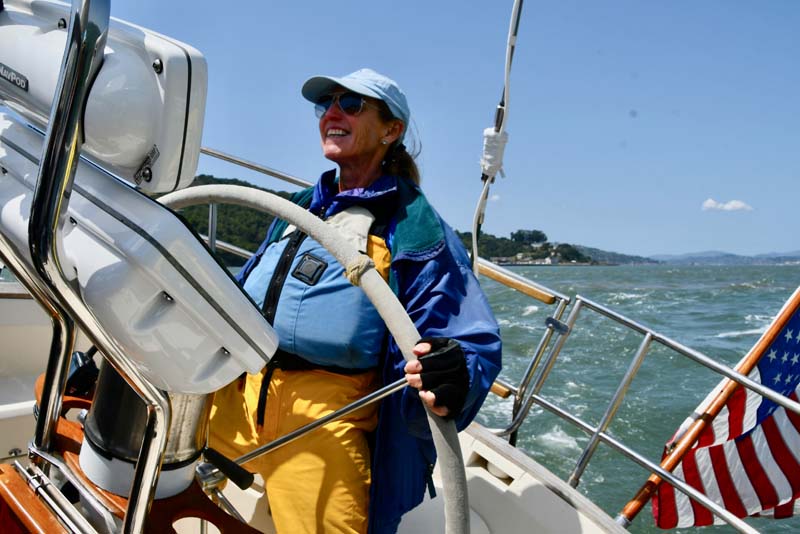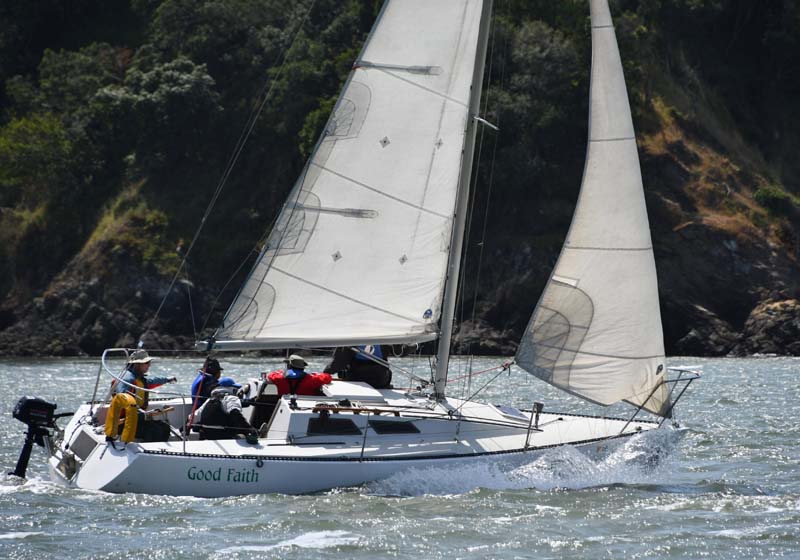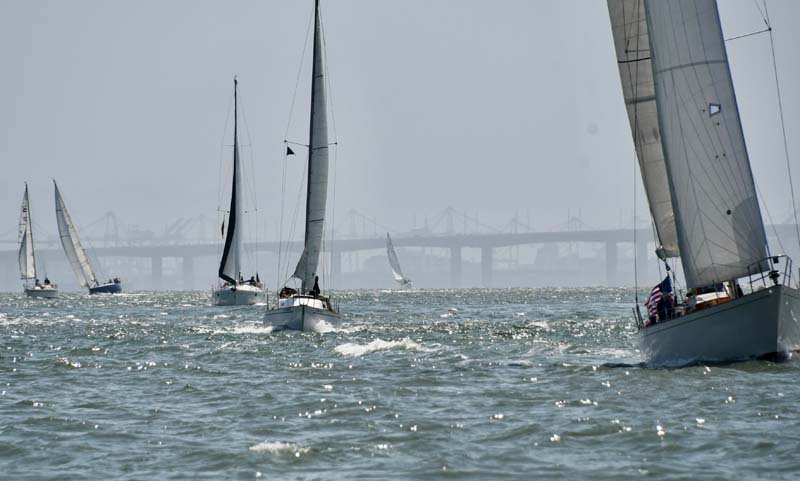
Third Time’s the Charm on Opening Day Weekend
Two years ago, Opening Day became a virtual event because of COVID. Last year the weather was misty and gray. But the third time’s the charm. Opening Day 2022 was about as good as it gets. A sunny, pleasant weekend welcomed all who hoisted their sails anywhere on the Bay, and all who passed through Belvedere Cove in Tiburon to have their boats blessed for the season by the minister, priest and rabbi aboard the anchored, classic Trumpy Aurora V. The first PICYA-sponsored Opening Day event happened in 1917, and it is a tradition still observed by the Bay Area’s 100+ member yacht clubs.









If you didn’t get out this past weekend you missed a great one. As these photos show, sailing San Francisco Bay is an adventure, a thing of beauty, a close-to-home escape, and a great way to spend time with family and friends. It’s one of the reasons we’re always suggesting you sign up for something — the Delta Doo Dah, the Vallejo Race, the Baja Ha-Ha (entries open May 11), the Delta Ditch Run, Summer Sailstice, and Opening Day on the Bay!
Check our Calendar for your next motivational sailing opportunity. If you’ve got your own photos from Opening Day send them to Sailagram at [email protected].
Kenichi Horie Passes Hawaii in Good Spirits
When we last reported on Kenichi Horie’s solo voyage from San Francisco to Japan on April 8, he was a little over halfway to Hawaii. Kenichi and Suntory Mermaid III are now 30 days into the journey, and the images we have seen indicate that all is well with the 83-year-old sailor.

As Kenichi passed Oahu, Hawaii, on April 16, he smiled and waved for the cameras, and at one point appeared to be preparing to hand off a bag to another boat. His accumulated trash perhaps?


The farther Kenichi sails, the briefer his logbook entries become. There’s only so much one can say about a day spent alone in a boat on the ocean, but as he approached and then passed the Hawaiian Islands, his brevity alluded only to a positive attitude. (Again, we may have missed a few nuances in the translation.)
He is eating well. April 20: “I also have an appetite. I changed from twice a day in the morning and evening to three meals. Curry rice in the morning, cornflakes in the day, and curry rice in the evening. I take this kind of menu once every two days. I am in good physical condition.”
Kenichi is enjoying the ability to communicate — unlike during his first crossing 60 years ago. April 21: “Three TV and radio interviews continued. I don’t think I’ve ever been interviewed during the voyage. For that reason, the indescribable ‘freshness’ after the interview is likely to become a habit.”
And between stretches of rough weather, he has even managed to wash his hair. April 24: “A weak southeasterly wind continues. It is traveling at 2.5 knots. I shampooed because the wind was weak. At the same time, I washed my whole body with seawater. I stopped wearing seawater from my head*. I didn’t wipe my body with a towel and left it to the trade winds. I’m happy.” (*We’re taking this to mean Kenichi rinsed his head with fresh water.)

We’ll continue to keep an eye on Kenichi Horie’s voyage and bring you updates. In the meantime, if you’d like to follow his journey daily, you can do so here: Suntory Mermaid III Logbook.
A Versatile and Pristine Hunter 46LE Ready to Cruise
Well cared-for and well-equipped, this three-cabin, two-head Hunter 46LE is in turnkey condition and ready to go. Refitted in 2020 with new sails, running rigging, canvas, house batteries, ground tackle, and dinghy with electric outboard and standing-rigging diagonals. New bottom paint in March.
Rio100 Smashes Newport to Ensenada Record
On Friday, Rio100, Manouch Moshayedi’s custom 100-ft Bakewell White, decimated the Newport to Ensenada International Yacht Race’s elapsed time record for a monohull with an unofficial finish of 7:02:17, a remarkable 2:33:17 less than the previous record set by Steve Maheen’s R/P 63 Aszhous in 2016. The record also represents the first time a monohull has crossed the finish line in Ensenada before sundown.

Not far astern in Rio100’s wake, the rest of the Maxi fleet — some also positioned to break the old record — battled for class honors. According to the YB tracker, multiple-time N2E winner Bill Gibbs’ Wahoo led the entire fleet down the coast until being passed by Rio100 off San Diego — about the time Wahoo’s spinnaker blew out. They recovered and were south of the border before Ray Paul’s 65-ft Botin Armetis passed by. Still, the 45-ft Schionning was the first ORCA-class boat to arrive, setting a new personal-best finish time for team Wahoo.

Friday morning winds that blew directly from the west at 18-20 knots off the Balboa Pier represented one of the windiest and bounciest starts in recent memory. Yet Moshayedi called the record-breaking conditions “Fantastic; a straight shot down the coast, a great experience!”

Included in the crew of 16 US- and New Zealand-based sailors were Manouch’s son Sebastian and Peter Isler. The win gives Isler the exclusive distinction of being part of two record-holding crews: the multihull record set by Tom Siebel’s MOD70 Orion in 2016, and now the monohull record set by Rio100.
By 1 a.m. about a dozen boats had crossed the finish line. Diminishing overnight winds of 4-8 knots slowed progress for some. All but a handful of boats out of the 164-boat fleet finished the 123-mile course within 24 hours. To see who finished when, check out https://nosa.org/race-results.
The Resourceful Sailor Tackles Air Circulation to Combat Condensation
As we head into summer you may wonder why we would run a story on condensation, which is usually more of a problem in the winter months. And therein lies the reason. If you start thinking about how to mitigate condensation now, by the time winter rolls around again chances are you will be better equipped to deal with it. So please enjoy The Resourceful Sailor’s DIY condensation solution, part 1.
If you live aboard or cruise on a boat in a temperate climate during the winter months, you may know a little about living with condensation. Running a heater, cooking, and just breathing raise both the temperature and water content of the air. The water condenses from this warm air on inside surfaces of the boat that are cooler, usually because they are also in contact with colder outside temperatures — portlights, cabin tops, hulls, fasteners, or inside lockers, to name a few. Such condensation can lead to all sorts of problems like mold and mildew, ruined books, rotting bulkheads, spoiled food, corrosion, and the list goes on.
Having lived aboard over 10 years in the Pacific Northwest, I have long contended with this nuisance aboard Sampaguita, a Pacific Seacraft Flicka 20 sailboat. While there are many facets to mitigating condensation, like how you heat, cook, and dehumidify, this installment will focus on one particular project I undertook to improve air circulation.
Air circulation helps keep the boat dry, and, once the inevitable condensation does occur, dry it out. On expedition, away from AC power sources, this likely means opening up hatches and getting outdoor air through the boat. Dressing warmly is key to that plan. At the dock, I have three fans going 24/7 during the winter months. I move them around depending on the temperatures and whether I will be on board. The intent is to maximize the airflow they create, getting movement to all different parts of the boat. In a cold, humid environment without airflow, condensation areas may take forever to dry.
On Sampaguita, this was especially problematic along the hull-to-deck joint. Flicka 20s are built with a plethora of fasteners here, providing strength. But each one is a drip point along this poorly insulated seam, and the molded-in bulwarks create both space for moisture-laden air and a vertical surface for the condensed water to run down. The builder added ceiling panels that concealed these structural components, creating a clean and ‘yachty’ feel in the cabin. For a light-use boat, success. But as an everyday warrior in the Pacific Northwest, I saw a developing issue. The water that condensed couldn’t dry. With gravity, boat list, and sheer, the water beaded and ran, soaking into the plywood ceiling panels, bulkheads, and carpeted hull, and stayed there. Mildew was taking hold, and some potential long-term effects foreseen on the structural bulkheads were alarming.

To mitigate this, I removed the ceiling panels and trimmed them each back a few inches from the hull and away from the dripping fasteners and bulwarks to open that space to the cabin. If I couldn’t stop the condensation, I gave it a fighting chance to dry out. It also gave me easy access to wiring tucked up in the bulwarks. It was an easy modification using a screwdriver and pliers to remove old corroded staples, a utility knife to cut the vinyl liner material, a jigsaw to cut the plywood ceiling panel, and a T50 stapler with stainless steel staples to put it back together. I succeeded in making the panels look as if they’d come this way from the factory.




So far, I am pleased with the results regarding this adjustment. It still condenses, but it also dries out. I can assess with a quick look how much condensation is forming and wipe a sponge along the drip points to remove the water. The trimmed panels look good, and the deck joint is still hidden, except by up-close inspection. If you wonder about regret over altering a classic interior, there is nothing sexy about mildew and rotting bulkheads.


I recognize and accept condensation as a natural part of the winter boat life. Stopping or ignoring it is foolhardy, so I manage it. The dryness of a wood-burning stove would be fantastic, but Sampaguita is not a good candidate for one, so I do what I can. Boats, locations, temperatures, people, and lifestyles will all add variables to contending with condensation. The Resourceful Sailor reminds you to be safe and prudent, and have a blast.


